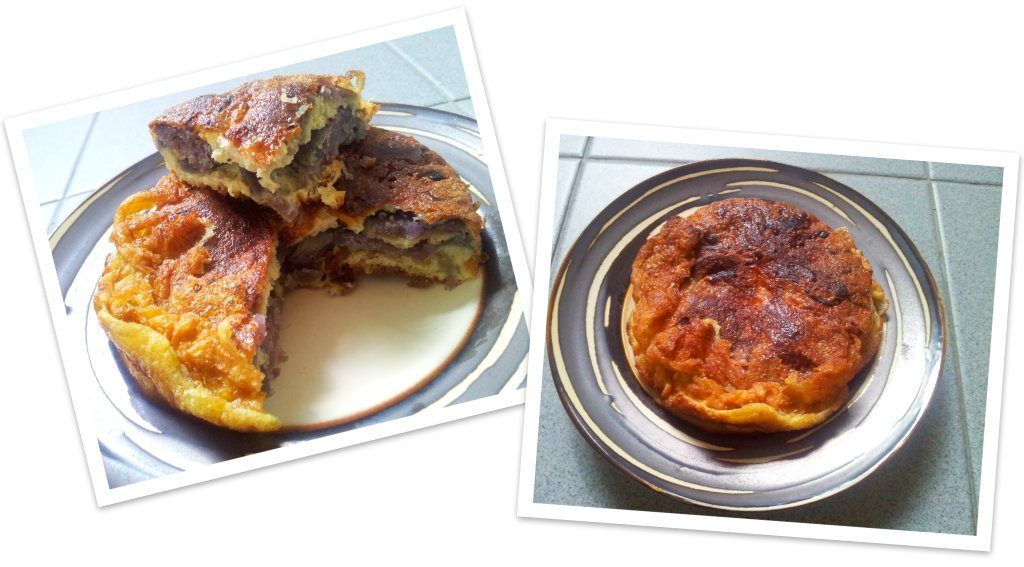I totally had to blog about this because I finally managed to cook this successfully at the third attempt. I guess this is what people say about the third time's a charm.
Besides the seafood paella, the Spanish omelette, which is known as Tortilla de Patatas or Tortilla Española in Spanish, is the other dish I that I couldn't forget after my recent Spain & Portugal trip so I searched the Internet for the recipe. Found a few, read them and the basic ingredients and steps are the same.
My first attempt was using the purple sweet potato because I didn't have any potato on hand and I was too eager to try cooking the dish. Sliced the sweet potato thinly to fry but I didn't use enough of it to cook the omelette. Also, I had probably over beaten the egg such that the side of the omelette fluff up a lot during the cooking. The end result was a crumpled and sweet omelette with a purple color interior. The exterior looked nothing close to those that I had eaten back in Spain. Conclusion: FAIL.
The second attempt was done at my little big sis's place last Saturday using russet potatoes. She did the cutting because she wanted to use the potatoes to cook her favourite dish - minced meat potato. So the potato slices were round and rather thick. Took a few slices to cook the omelette and again I failed. The potato slices couldn't line bottom of the pan nicely and again I made the mistake of over beating the egg. The end result was a crumpled and crumbling omelette because the potato slices were falling out of the egg. Conclusion: EPIC FAIL.
Interestingly, there was an article about this dish in The Straits Times the next day, recipe included. I was so happy and cut the article out to keep.
Little big sis gave me the one and only leftover russet potato since she had no use for it. So finally I managed to find the chance to do the third attempt of the dish today. I pondered over what had gone wrong in the previous two attempts and made some modifications to the way I cook it today.
Instead of slicing the potatoes, I cut them into strips of about 0.5cm thick. Then I just lightly beat the egg enough to combine the yolk and white without creating too much air bubbles. The rest of the steps were based on my memory of those recipes I had read and the amount of ingredients used were based on my own estimations.
Using about two tablespoons of olive oil, some salt and pepper to taste, I fried the potato strips till soften then added in the shallots slices (because I didn't have onion on hand) and fried till they became transparent. Drained the oil to be used later and set the potato strip aside in a bowl to cool. Then lightly beat an egg, adding a little bit of salt and pepper to taste.
After the potato strips were cooled enough, I chose those thinner and smaller ones to add into the beaten egg and added just enough pieces for the egg to cover them. It came to be about half of a medium size potato. Instead of heating up the oil and then add in the mixture, I added the oil to a 12-cm pan and then poured the mixture in, spreading the potato strips evenly so that the egg mixture covered them before turning up the heat.
I cooked the omelette over low heat and once the side of the omelette was set, I used a spatula to loosen the side and bottom of the omelette. Then took a plate that was bigger than the pan, turned it upside down to cover the pan and flipped both over so that the omelette fell onto the plate. Added a bit more oil to the pan before sliding the omelette back into it to cook the other side which took about two to three minutes.
Off the heat and transferred the omelette to a serving plate to take photos. This time round, both the exterior and interior of the omelette looked much closer to those I had eaten back in Spain. Perhaps, a slight adjustment the next time will be to cut the strips a little bit thinner.
Another interesting thing I found out was that the type of potato that was called for in most of the recipe is the waxy kind but the wikipedia states that the starchy kind is more ideal for the dish. How ironic.



No comments:
Post a Comment